What Are Quantum Gravity’s Alternatives To String Theory?

If there is a quantum theory of gravity, is String Theory the only game in town?
“I just think too many nice things have happened in string theory for it to be all wrong. Humans do not understand it very well, but I just don’t believe there is a big cosmic conspiracy that created this incredible thing that has nothing to do with the real world.” –Edward Witten
The Universe we know and love — with Einstein’s General Relativity as our theory of gravity and quantum field theories of the other three forces — has a problem that we don’t often talk about: it’s incomplete, and we know it. Einstein’s theory on its own is just fine, describing how matter-and-energy relate to the curvature of space-and-time. Quantum field theories on their own are fine as well, describing how particles interact and experience forces. Normally, the quantum field theory calculations are done in flat space, where spacetime isn’t curved. We can do them in the curved space described by Einstein’s theory of gravity as well (although they’re harder — but not impossible — to do), which is known as semi-classical gravity. This is how we calculate things like Hawking radiation and black hole decay.
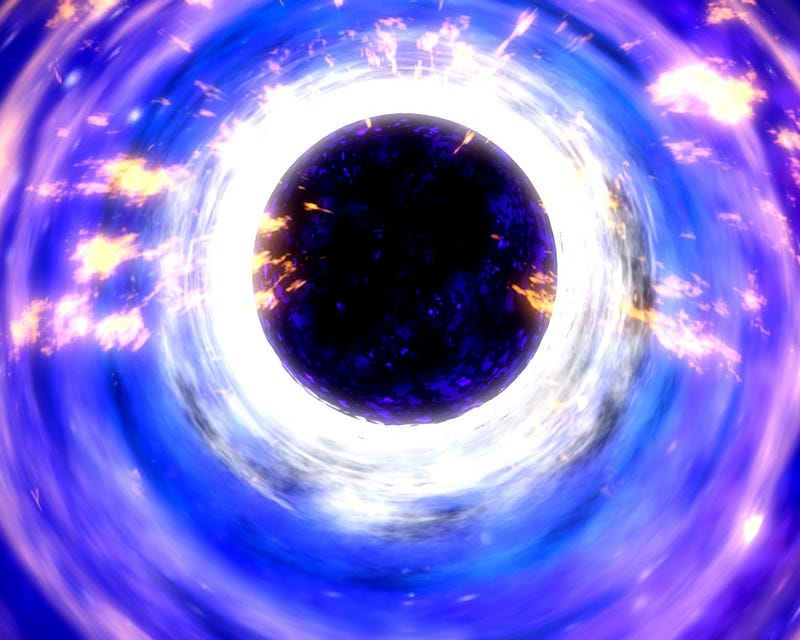
But even that semi-classical treatment is only valid near and outside the black hole’s event horizon, not at the location where gravity is truly at its strongest: at the singularities (or the mathematically nonsensical predictions) theorized to be at the center. There are multiple physical instances where we need a quantum theory of gravity, all having to do with strong gravitational physics on the smallest of scales: at tiny, quantum distances. Important questions, such as:
- What happens to the gravitational field of an electron when it passes through a double slit?
- What happens to the information of the particles that form a black hole, if the black hole’s eventual state is thermal radiation?
- And what is the behavior of a gravitational field/force at and around a singularity?
all go unanswered without a quantum theory of gravity.
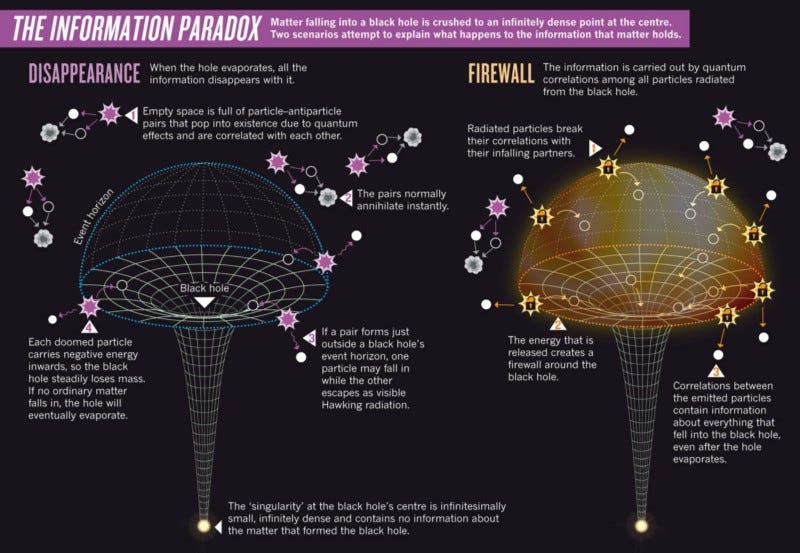
In order to explain what happens at short distances in the presence of gravitational sources — or masses — we need a quantum, discrete, and hence particle-based theory of gravity. The known quantum forces are mediated by particles known as bosons, or particles with integer spin. The photon mediates the electromagnetic force, the W-and-Z bosons mediate the weak force, while the gluons mediate the strong force. All these types of particles have a spin of 1, which for massive (W-and-Z) particles mean they can take on spin values of -1, 0, or +1, while for massless ones (like gluons and photons), they can take on values of -1 or +1 only.
The Higgs boson is also a boson, although it doesn’t mediate any forces, and has a spin of 0. Because of what we know about gravitation — General Relativity is a tensor theory of gravity — it must be mediated by a massless particle with a spin of 2, meaning it can take on a spin value of -2 or +2 only.
This is fantastic! It means that we already know a few things about a quantum theory of gravity before we even try to formulate one! We know this because whatever the true quantum theory of gravity turns out to be, it must be consistent with General Relativity when we’re not at very small distances from a massive particle or object, just as — 100 years ago — we knew that General Relativity needed to reduce to Newtonian gravity in the weak-field regime.
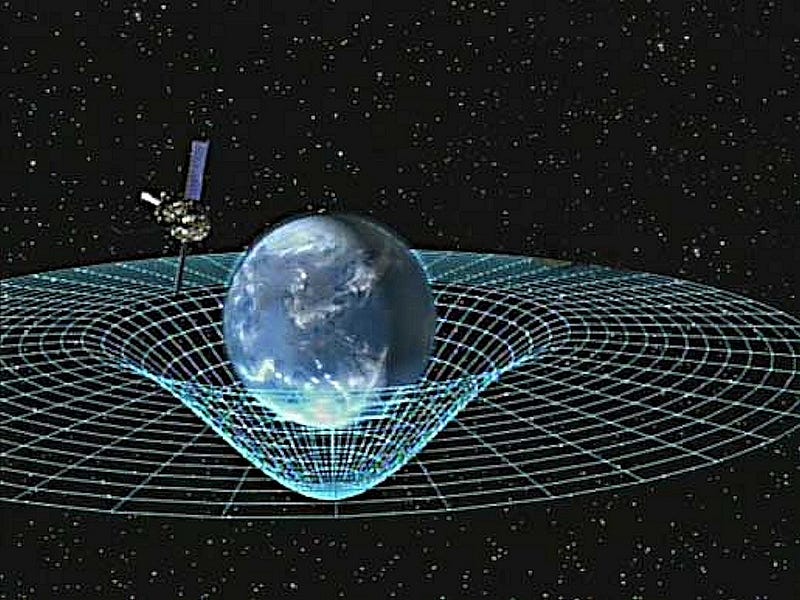
The big question, of course is how? How do you quantize gravity in a way that’s correct (at describing reality), consistent (with both GR and QFT), andhopefully leads to calculable predictions for new phenomena that might be observed, measured or somehow tested. The leading contender, of course, is something you’ve long heard of: String Theory.
String Theory is an interesting framework — it can include all of the standard model fields and particles, both the fermions and the bosons. It includes also a 10-dimensional Tensor-Scalar theory of gravity: with 9 space and 1 time dimensions, and a scalar field parameter. If we erase six of those spatial dimensions (through an incompletely defined process that people just callcompactification) and let the parameter (ω) that defines the scalar interaction go to infinity, we can recover General Relativity.
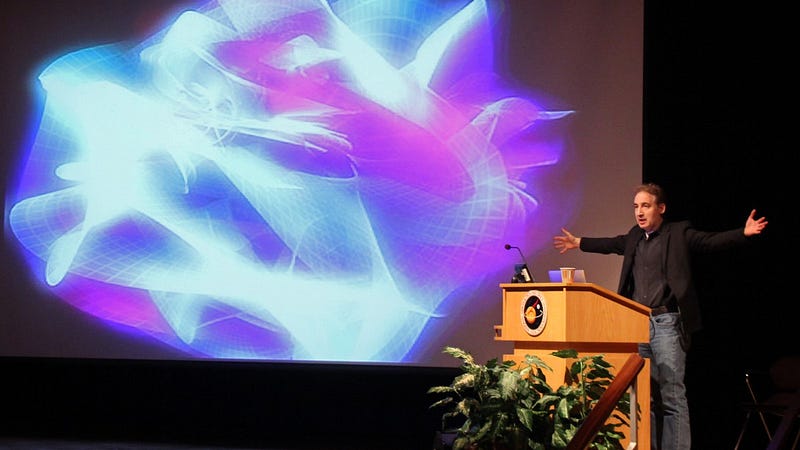
But there are a whole host of phenomenological problems with String Theory. One is that it predicts a large number of new particles, including all the supersymmetric ones, none of which have been found. It claims to not need to need “free parameters” like the standard model has (for the masses of the particles), but it replaces that problem with an even worse one. String theory refers to “10⁵⁰⁰ possible solutions,” where these solutions refer to the vacuum expectation values of the string fields, and there’s no mechanism to recover them; if you want String Theory to work, you need to give up on dynamics, and simply say, “well, it must’ve been anthropically selected.” There are frustrations, drawbacks, and problems with the very idea of String Theory. But the biggest problem with it may not be these mathematical ones. Instead, it may be that there are four other alternatives that may lead us to quantum gravity instead; approaches that are completely independent of String Theory.

1.) Loop Quantum Gravity. LQG is an interesting take on the problem: rather than trying to quantize particles, LQG has as one of its central features that space itself is discrete. Imagine a common analogy for gravity: a bedsheet pulled taut, with a bowling ball in the center. Rather than a continuous fabric, though, we know that the bedsheet itself is really quantized, in that it’s made up of molecules, which in turn are made of atoms, which in turn are made of nuclei (quarks and gluons) and electrons.
Space might be the same way! Perhaps it acts like a fabric, but perhaps it’s made up of finite, quantized entities. And perhaps it’s woven out of “loops,” which is where the theory gets it name from. Weave these loops together and you get a spin network, which represents a quantum state of the gravitational field. In this picture, not just the matter itself but space itself is quantized. The way to go from this idea of a spin network to a perhaps realistic way of doing gravitational computations is an active area of research, one that saw a tremendous leap forward made in just 2007/8, so this is still actively advancing.
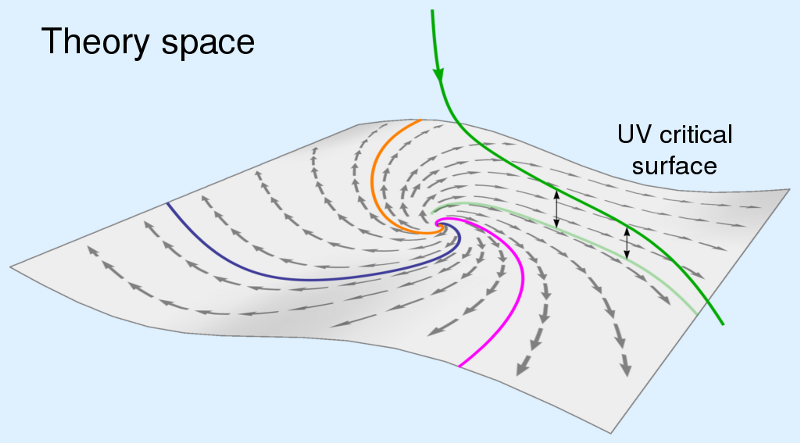
2.) Asymptotically Safe Gravity. This is my personal favorite of the attempts at a quantum theory of gravity. Asymptotic freedom was developed in the 1970s to explain the unusual nature of the strong interaction: it was a very weak force at extremely short distances, then got stronger as (color) charged particles got farther and farther apart. Unlike electromagnetism, which had a very small coupling constant, the strong force has a large one. Due to some interesting properties of QCD, if you wound up with a (color) neutral system, the strength of the interaction fell off rapidly. This was able to account for properties like the physical sizes of baryons (protons and neutrons, for example) and mesons (pions, for example).
Asymptotic safety, on the other hand, looks to solve a fundamental problem that’s related to this: you don’t need small couplings (or couplings that tend to zero), but rather for the couplings to simply be finite in the high-energy limit. All coupling constants change with energy, so what asymptotic safety does is pick a high-energy fixed point for the constant (technically, for the renormalization group, from which the coupling constant is derived), and then everything else can be calculated at lower energies.
At least, that’s the idea! We’ve figured out how to do this in 1+1 dimensions (one space and one time), but not yet in 3+1 dimensions. Still, progress has been made, most notably by Christof Wetterich, who had two groundbreakingpapers in the 1990s. More recently, Wetterich used asymptotic safety — just six years ago — to calculate a prediction for the mass of the Higgs boson before the LHC found it. The result?

Amazingly, what it indicated was perfectly in line with what the LHC wound up finding. It’s such an amazing prediction that if asymptotic safety is correct, and — when the error bars are beaten down further — the masses of the top quark, the W-boson and the Higgs boson are finalized, there may not even be a need for any other fundamental particles (like SUSY particles) for physics to be stable all the way up to the Planck scale. It’s not only very promising, it has many of the same appealing properties of string theory: quantizes gravity successfully, reduces to GR in the low energy limit, and is UV-finite. In addition, it beats string theory on at least one account: it doesn’t need the addition of new particles or parameters that we have no evidence for! Of all the string theory alternatives, this one is my favorite.
3.) Causal Dynamical Triangulations. This idea, CDT, is one of the new kids in town, first developed only in 2000 by Renate Loll and expanded on by others since. It’s similar to LQG in that space itself is discrete, but is primarily concerned with how that space itself evolves. One interesting property of this idea is that time must be discrete as well! As an interesting feature, it gives us a 4-dimensional spacetime (not even something put in a priori, but something that the theory gives us) at the present time, but at very, very high energies and small distances (like the Planck scale), it displays a 2-dimensional structure. It’s based on a mathematical structure called asimplex, which is a multi-dimensional analogue of a triangle.

A 2-simplex is a triangle, a 3-simplex is a tetrahedron, and so on. One of the “nice” features of this option is that causality — a notion held sacred by most human beings — is explicitly preserved in CDT. (Sabine has some words on CDT here, and its possible relation to asymptotically safe gravity.) It might be able to explain gravity, but it isn’t 100% certain that the standard model of elementary particles can fit suitably into this framework. It’s only major advances in computation that have enabled this to become a fairly well-studied alternative of late, and so work in this is both ongoing and relatively young.
4.) Emergent gravity. And finally, we come to what’s probably the most speculative, recent of the quantum gravity possibilities. Emergent gravity only gained prominence in 2009, when Erik Verlinde proposed entropic gravity, a model where gravity was not a fundamental force, but rather emerged as a phenomenon linked to entropy. In fact, the seeds of emergent gravity go back to the discoverer of the conditions for generating a matter-antimatter asymmetry, Andrei Sakharov, who proposed the concept back in 1967. This research is still in its infancy, but as far as developments in the last 5–10 years go, it’s hard to ask for more than this.
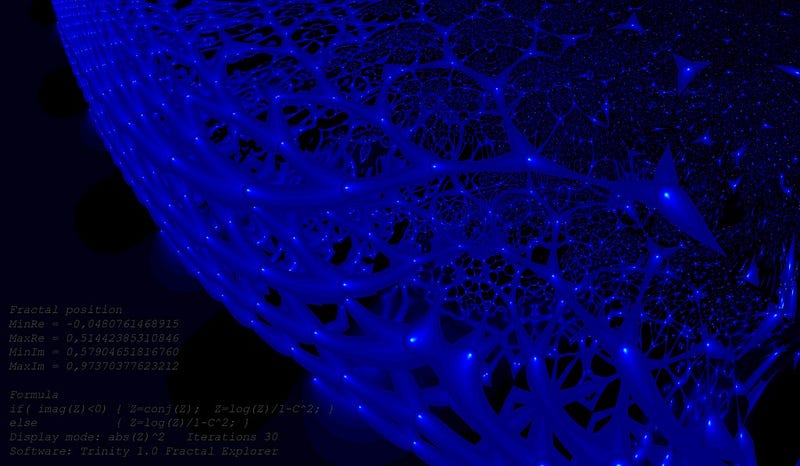
We’re sure we need a quantum theory of gravity to make the Universe work at a fundamental level, but we’re not sure what that theory looks like or whether any of these five avenues (string theory included) are going to prove fruitful or not. String Theory is the best studied of all the options, but Loop Quantum Gravity is a rising second, with the others being given serious consideration at long last. They say the answer’s always in the last place you look, and perhaps that’s motivation enough to start looking, seriously, in newer places.
Leave your comments on our forum, help Starts With A Bang! deliver more rewards on Patreon, and order our first book, Beyond The Galaxy, out now!





